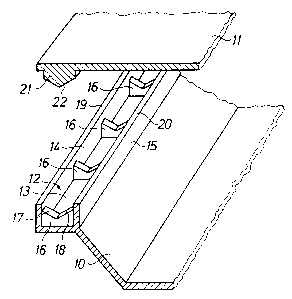Some of the information on this Web page has been provided by external sources. The Government of Canada is not responsible for the accuracy, reliability or currency of the information supplied by external sources. Users wishing to rely upon this information should consult directly with the source of the information. Content provided by external sources is not subject to official languages, privacy and accessibility requirements.
Any discrepancies in the text and image of the Claims and Abstract are due to differing posting times. Text of the Claims and Abstract are posted:
| (12) Patent Application: | (11) CA 2371856 |
|---|---|
| (54) English Title: | METHOD OF INTERCONNECTING TWO ELEMENTS |
| (54) French Title: | PROCEDE PERMETTANT D'INTERCONNECTER DEUX ELEMENTS |
| Status: | Deemed Abandoned and Beyond the Period of Reinstatement - Pending Response to Notice of Disregarded Communication |
| (51) International Patent Classification (IPC): |
|
|---|---|
| (72) Inventors : |
|
| (73) Owners : |
|
| (71) Applicants : |
|
| (74) Agent: | MARKS & CLERK |
| (74) Associate agent: | |
| (45) Issued: | |
| (86) PCT Filing Date: | 2000-02-16 |
| (87) Open to Public Inspection: | 2000-08-24 |
| Availability of licence: | N/A |
| Dedicated to the Public: | N/A |
| (25) Language of filing: | English |
| Patent Cooperation Treaty (PCT): | Yes |
|---|---|
| (86) PCT Filing Number: | PCT/SE2000/000298 |
| (87) International Publication Number: | WO 2000049843 |
| (85) National Entry: | 2001-08-17 |
| (30) Application Priority Data: | ||||||
|---|---|---|---|---|---|---|
|
In a method of interconnecting two elements (10, 11) of plastic material by
welding or gluing together surfaces of the elements a channel (12) is formed
in one of said elements, which is divided by partitions (16) into individual
spaces distributed longitudinally of the channel. The partitions and the side
walls (14, 15) of the channel along the edge surfaces (17, 18, 19, 20) thereof
are connected with the other element (11) by welding or gluing together said
edge surfaces.
La présente invention concerne un procédé permettant d'interconnecter deux éléments (10, 11) en matière plastique par soudage ou collage des surfaces de ces éléments. L'un de ces éléments est formé d'un canal (12), qui est divisé par des séparations (16) en espaces individuels répartis longitudinalement sur le canal. Les séparations et les parois latérales (14, 15) du canal au niveau de leurs bords de surface (17, 18, 19, 20) sont connectés à l'autre élément (11) par soudage ou collage.
Note: Claims are shown in the official language in which they were submitted.
Note: Descriptions are shown in the official language in which they were submitted.

2024-08-01:As part of the Next Generation Patents (NGP) transition, the Canadian Patents Database (CPD) now contains a more detailed Event History, which replicates the Event Log of our new back-office solution.
Please note that "Inactive:" events refers to events no longer in use in our new back-office solution.
For a clearer understanding of the status of the application/patent presented on this page, the site Disclaimer , as well as the definitions for Patent , Event History , Maintenance Fee and Payment History should be consulted.
| Description | Date |
|---|---|
| Inactive: IPC from MCD | 2006-03-12 |
| Inactive: IPC from MCD | 2006-03-12 |
| Inactive: IPC from MCD | 2006-03-12 |
| Application Not Reinstated by Deadline | 2004-02-16 |
| Time Limit for Reversal Expired | 2004-02-16 |
| Deemed Abandoned - Failure to Respond to Maintenance Fee Notice | 2003-02-17 |
| Letter Sent | 2002-07-25 |
| Inactive: Single transfer | 2002-05-17 |
| Inactive: Cover page published | 2002-03-19 |
| Inactive: Courtesy letter - Evidence | 2002-03-19 |
| Inactive: Notice - National entry - No RFE | 2002-03-15 |
| Application Received - PCT | 2002-03-13 |
| Application Published (Open to Public Inspection) | 2000-08-24 |
| Abandonment Date | Reason | Reinstatement Date |
|---|---|---|
| 2003-02-17 |
The last payment was received on 2001-08-17
Note : If the full payment has not been received on or before the date indicated, a further fee may be required which may be one of the following
Please refer to the CIPO Patent Fees web page to see all current fee amounts.
| Fee Type | Anniversary Year | Due Date | Paid Date |
|---|---|---|---|
| Basic national fee - standard | 2001-08-17 | ||
| MF (application, 2nd anniv.) - standard | 02 | 2002-02-18 | 2001-08-17 |
| Registration of a document | 2002-05-17 |
Note: Records showing the ownership history in alphabetical order.
| Current Owners on Record |
|---|
| TELEFONAKTIEBOLAGET LM ERICSSON |
| Past Owners on Record |
|---|
| PER HOLMBERG |